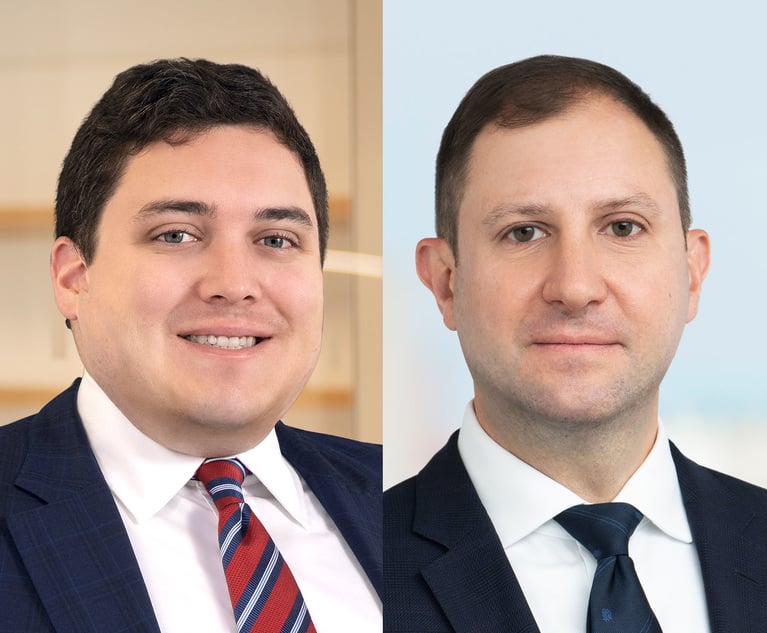Federal Circuit Appears to Settle Question of Patent-Eligibility Presumption
The court's unanimous and precedential decision clarifies that issued U.S. patents should indeed be accorded a presumption of eligibility.
September 05, 2019 at 01:00 PM
8 minute read
 Credit: yavyav/Shutterstock.com
Credit: yavyav/Shutterstock.com
The U.S. Supreme Court's 2014 decision in Alice Corp. v. CLS Bank International, 573 U.S. 208 (2014), triggered a veritable tsunami of successful challenges to patent-eligibility and breathed new life into a mostly dormant 35 U.S.C. §101. The last few years have seen the pendulum swinging back, with the U.S. Court of Appeals for the Federal Circuit upholding patent claims as eligible under Section 101 more frequently than in the years immediately post-Alice. Changes in the procedural landscape for eligibility challenges have also somewhat stemmed the tide of patents found ineligible under Section 101.
Still, until recently, an important question remained open: does the presumption of patent validity under 35 U.S.C. §282 also include or require a presumption that claims are patent-eligible under Section 101? On June 25, 2019, in Cellspin Soft v. Fitbit, 927 F.3d 1306, 1319 (Fed. Cir. 2019), the Federal Circuit addressed the issue in a unanimous and precedential decision, clarifying that issued U.S. patents should indeed be accorded a presumption of eligibility.
Background
In the wake of Alice, the question of an eligibility presumption had deeply divided district courts, with courts that declined to apply a presumption frequently citing to Judge Rader's concurring opinion in Ultramercial v. Hulu, 772 F.3d 709 (Fed. Cir. 2014), which stated that "no presumption of eligibility attends the section 101 inquiry." Id. at 717. For example, in Wireless Media Innovations v. Maher Terminals, 100 F. Supp. 3d 405 (D.N.J. 2015), then-Judge Linares of the District of New Jersey noted the lack of any "authoritative law binding the [c]ourt" and therefore "adopt[ed] Judge Mayer's approach" by declining to afford the plaintiff's asserted patents a presumption of eligibility. Id. at 411.
Courts favoring a presumption of eligibility, on the other hand, often relied on Judge Lourie's concurring opinion in CLS Bank International v. Alice Corp. Pty., 717 F.3d 1269 (Fed. Cir. 2013), which stated: "as with obviousness and enablement, [the] presumption [of validity] applies when [Section] 101 is raised as a basis for invalidity in district court proceedings." Id. at 1284. In Scibetta v. Slingo, No. 16-8175, 2018 WL 466224 (D.N.J. Jan. 17, 2018), the District of New Jersey's Judge Vazquez quoted this language from Judge Lourie's concurring opinion in finding that a presumption of eligibility applies in Section 101 challenges. Id. at *9.
Until the decision in Cellspin, however, no precedential opinion from the Federal Circuit squarely addressed this question.
The Cellspin Decision
The case began with Cellspin Soft's suits against Fitbit and numerous other defendants for alleged infringement of four patents, all of which generally relate to "connecting a data capture device, e.g., a digital camera, to a mobile device so that a user can automatically publish content from the data capture device to a website." Cellspin, 927 F.3d at 1309. The defendants moved the district court to dismiss Cellspin's complaints on the ground that the asserted claims of all four patents recited patent-ineligible subject matter under Section 101. Id. at 1309, 1312. Applying the two-step framework for analyzing patent-eligibility articulated in Alice and May Collaborative Services v. Prometheus Laboratories, 566 U.S. 66 (2012), the district court granted the defendants' motions, agreeing that the claims were directed to the abstract idea of "acquiring, transferring, and publishing data and multimedia content on one or more websites" and recited no inventive concept. Id. at 1312-13; Cellspin v. Fitbit ("District Court Op."), 316 F. Supp. 3d 1138, 1148-55 (N.D. Cal. 2018).
Several defendants subsequently sought attorney fees, which the district court awarded upon finding the cases "exceptional" under 35 U.S.C. §285. Cellspin, 927 F.3d at 1313-14; Cellspin v. Fitbit ("Fees Order"), No. 4:17-CV-5928, 2018 WL 3328164 (N.D. Cal. July 6, 2018). In doing so, the district court faulted Cellspin for "aggressively" pursuing over a dozen simultaneous suits out of the gate rather than first filing a "test case" to adjudicate the validity of its patents. Cellspin, 927 F.3d at 1314; Fees Order, at *4. The court rejected Cellspin's argument that it need not file a test case because its patents were presumptively valid, holding that "[a]lthough issued patents are presumed valid, they are not presumed eligible under Section 101." Fees Order, at *4; Cellspin, 927 F.3d at 1314.
On appeal to the Federal Circuit, Cellspin challenged both the district court's Section 101 ruling and its attorney fee award. In a unanimous opinion by Judge Lourie, the panel, which included Judges O'Malley and Taranto, explained that the district court misapplied Federal Circuit precedent in finding Cellspin's patents ineligible under Section 101. Cellspin, 927 F.3d at 1309. At step one of the Alice-Mayo patent-eligibility framework, the court agreed that the claims were directed to an abstract idea, namely "capturing and transmitting data from one device to another." Id. at 1315. However, at step two, the court concluded that the district court erred in finding that the claims lacked an inventive concept. Id. at 1316-19. The panel noted that Cellspin's complaint offered "specific, plausible factual allegations about why" aspects of the claims were inventive, and found that the district court erred in discounting these allegations at the pleading stage. Id. The court held that there was "no basis, at the pleadings stage," to conclude that the allegedly inventive aspects of the claims "were well-known or conventional as a matter of law" and accordingly vacated the district court's dismissal of Cellspin's complaint Id. at 1318, 1320.
Because vacatur of the district court's Section 101 ruling meant that the defendants were no longer prevailing parties under Section 285, the court also vacated the district court's fee award. Id. at 1319. "In the interest of judicial economy," the court went further and turned its attention to "certain errors in the district court's attorney fees analysis that could remain on … remand." Id. Addressing the district court's reasoning that "Cellspin should have filed a 'test case' before asserting its patents here," the court noted that issued patents are "presumptively valid" and explained that "[t]o the extent the district court departed from this principle by concluding that issued patents are presumed valid but not presumed patent eligible, it was wrong to do so," id., thus clearly endorsing a presumption of patent-eligibility under Section 101.
Commentary and Conclusions for Practitioners
With its focus on "specific, plausible factual allegations" at step two of the Alice analysis, id. at 1317-18, the Cellspin decision further reshapes the shifting procedural landscape for patent eligibility challenges under Section 101. As some commentators have recognized, the Cellspin decision "continues the trend" of cases that have made "Alice challenges more difficult for accused infringers to win early in a case." Fed. Circ. Ruling May Mean Higher Bar for Alice Motions, Law360 (June 28, 2019).
Cellspin's endorsement of an eligibility presumption also appears at first glance to be an unqualified win for patent owners, arming them with another tool for overcoming or staving off eligibility challenges by accused infringers. Indeed, commentators have "chalk[ed] up" the Cellspin decision as "a win for patentees." CAFC: Patents Enjoy a Presumption of Subject Matter Eligibility, Lexology (July 1, 2019). Others have opined that there is "no longer a debate" over an eligibility presumption. Federal Circuit Elucidates Berkheimer and Aatrix; Patents Presumed Eligible, Lexology (July 1, 2019). Still others predict that "[t]he success rate for Alice motions could drop even further" due to the decision in Cellspin. Quick Alice Wins Dwindling In Wake Of Berkheimer Ruling, Law360 (July 25, 2019).
But there may be more to the Cellspin decision than meets the eye. The court's endorsement of an eligibility presumption arose, somewhat unusually, in the context of addressing the propriety of attorney fees under Section 285, rather than in a discussion of the merits of the defendants' Section 101 challenge. See Cellspin, 927 F.3d at 1319. The court vacated the district court's fee award solely due to the absence of a "prevailing party" under Section 285 and expressly noted that it was addressing the eligibility-presumption question "[i]n the interest of judicial economy," as it could remain an "issue[] on remand." Id. The unusual posture of the court's discussion naturally begs the question whether district courts or future Federal Circuit panels might treat Cellspin's endorsement of an eligibility presumption as dicta rather than binding and authoritative. See Nat'l Am. Ins. Co. v. United States, 498 F.3d 1301, 1306 (Fed. Cir. 2007) ("Dicta, as defined by this court, are statements made by a court that are unnecessary to the decision in the case[.]"). On the other hand, even if considered dicta, the court's pronouncement may be given persuasive weight, given the absence of any other precedential opinion from the Federal Circuit addressing the issue. Only time will tell how the Court's endorsement of an eligibility presumption will impact future Section 101 challenges.
James J. DeCarlo is a shareholder in the Intellectual Property and Technology Practice at Greenberg Traurig in Florham Park. Vishesh Narayen is an associate with the firm, focusing his practice on complex intellectual property litigation.
This article reflects the opinions of the authors, and not of Greenberg Traurig, LLP. The article is presented for informational purposes only and it is not intended to be construed or used as general legal advice nor as a solicitation of any type.
This content has been archived. It is available through our partners, LexisNexis® and Bloomberg Law.
To view this content, please continue to their sites.
Not a Lexis Subscriber?
Subscribe Now
Not a Bloomberg Law Subscriber?
Subscribe Now
NOT FOR REPRINT
© 2025 ALM Global, LLC, All Rights Reserved. Request academic re-use from www.copyright.com. All other uses, submit a request to [email protected]. For more information visit Asset & Logo Licensing.
You Might Like
View All
Neighboring States Have Either Passed or Proposed Climate Superfund Laws—Is Pennsylvania Next?
7 minute read
An Overview of Proposed Changes to the Federal Rules of Procedure Relating to the Expansion of Remote Trial Testimony
15 minute readTrending Stories
- 1No Two Wildfires Alike: Lawyers Take Different Legal Strategies in California
- 2Poop-Themed Dog Toy OK as Parody, but Still Tarnished Jack Daniel’s Brand, Court Says
- 3Meet the New President of NY's Association of Trial Court Jurists
- 4Lawyers' Phones Are Ringing: What Should Employers Do If ICE Raids Their Business?
- 5Freshfields Hires Ex-SEC Corporate Finance Director in Silicon Valley
Who Got The Work
J. Brugh Lower of Gibbons has entered an appearance for industrial equipment supplier Devco Corporation in a pending trademark infringement lawsuit. The suit, accusing the defendant of selling knock-off Graco products, was filed Dec. 18 in New Jersey District Court by Rivkin Radler on behalf of Graco Inc. and Graco Minnesota. The case, assigned to U.S. District Judge Zahid N. Quraishi, is 3:24-cv-11294, Graco Inc. et al v. Devco Corporation.
Who Got The Work
Rebecca Maller-Stein and Kent A. Yalowitz of Arnold & Porter Kaye Scholer have entered their appearances for Hanaco Venture Capital and its executives, Lior Prosor and David Frankel, in a pending securities lawsuit. The action, filed on Dec. 24 in New York Southern District Court by Zell, Aron & Co. on behalf of Goldeneye Advisors, accuses the defendants of negligently and fraudulently managing the plaintiff's $1 million investment. The case, assigned to U.S. District Judge Vernon S. Broderick, is 1:24-cv-09918, Goldeneye Advisors, LLC v. Hanaco Venture Capital, Ltd. et al.
Who Got The Work
Attorneys from A&O Shearman has stepped in as defense counsel for Toronto-Dominion Bank and other defendants in a pending securities class action. The suit, filed Dec. 11 in New York Southern District Court by Bleichmar Fonti & Auld, accuses the defendants of concealing the bank's 'pervasive' deficiencies in regards to its compliance with the Bank Secrecy Act and the quality of its anti-money laundering controls. The case, assigned to U.S. District Judge Arun Subramanian, is 1:24-cv-09445, Gonzalez v. The Toronto-Dominion Bank et al.
Who Got The Work
Crown Castle International, a Pennsylvania company providing shared communications infrastructure, has turned to Luke D. Wolf of Gordon Rees Scully Mansukhani to fend off a pending breach-of-contract lawsuit. The court action, filed Nov. 25 in Michigan Eastern District Court by Hooper Hathaway PC on behalf of The Town Residences LLC, accuses Crown Castle of failing to transfer approximately $30,000 in utility payments from T-Mobile in breach of a roof-top lease and assignment agreement. The case, assigned to U.S. District Judge Susan K. Declercq, is 2:24-cv-13131, The Town Residences LLC v. T-Mobile US, Inc. et al.
Who Got The Work
Wilfred P. Coronato and Daniel M. Schwartz of McCarter & English have stepped in as defense counsel to Electrolux Home Products Inc. in a pending product liability lawsuit. The court action, filed Nov. 26 in New York Eastern District Court by Poulos Lopiccolo PC and Nagel Rice LLP on behalf of David Stern, alleges that the defendant's refrigerators’ drawers and shelving repeatedly break and fall apart within months after purchase. The case, assigned to U.S. District Judge Joan M. Azrack, is 2:24-cv-08204, Stern v. Electrolux Home Products, Inc.
Featured Firms
Law Offices of Gary Martin Hays & Associates, P.C.
(470) 294-1674
Law Offices of Mark E. Salomone
(857) 444-6468
Smith & Hassler
(713) 739-1250








